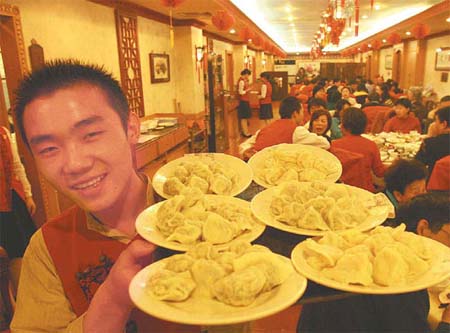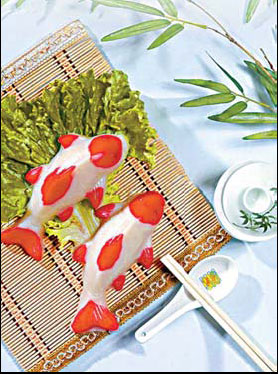A waiter at a Beijing restaurant serves jiaozi, dumplings, during the Spring Festival.
Most people agree there's nothing quite like mom's home cooking. And this is one among the many reasons hundreds of millions of Chinese pack overcrowded trains this season to return to their hometowns to feast with family and friends.
For many of them, it's the first taste of home they've had in a year. And when they finally do sit at their loved ones' tables, a wide array of terrific treats will be theirs for the tasting.
Traditionally, the celebration starts with xiaonian - the 23rd of the last month in the lunar calendar (Jan 30), and ends on the Lantern Festival - the 15th day after Spring Festival (Feb 21).
In between falls lichun (Feb 4), which marks the official beginning of spring. The special food served on this day is a thin, flat baked spring pancake called chunbing. These are larger than those served with Peking roast duck, and they come with green bean sprouts to wrap inside.
Two delicacies are considered musts during this season. Niangao, a rice or millet cake, is essential for people from both south and north. The name literally translates as "year cake", and the understood meaning is "better every year" - a particularly auspicious name, indeed.
Niangao are often featured in the first meal of the year in Shanghai, and the cakes are sometimes boiled along with round rice dumplings or noodles - symbols of a better year, family reunion and longevity.
Jiaozi, or boiled dumplings, are more popular in North China. The shape of this food is considered auspicious, because it resembles yuanbao (shoe-shaped golden or silver ingots used as money in ancient China).
Jiaozi are made with a flour-dough wrapping packed with nearly every imaginable kind of stuffing - meat, egg, seafood and vegetables. They are served with vinegar, garlic and soy sauce with generous amounts of sesame oil.
There are also deep-fried and steamed jiaozi, called guotie. In North China, jiaozi is always served for the first meal of the Chinese New Year. In Beijing, people sometimes hide a coin or candy in one of the dumplings, and the diner who bites the hidden treasure is believed to be in for a very good year.
Beijingers also make steamed rice cakes with red Chinese jujube, served with sugar, while people in Hebei and Shanxi provinces prefer deep-fried millet cake with mashed red bean or jujube stuffing.
In South China, in addition to steamed and deep-fried rice cakes, people also cut dried ones into slices to fry in dishes with other ingredients, or to add to soup. Rice cakes are also made into sweet dim sum flavors with rose, osmanthus flowers or mint.
Families throughout China start shopping in preparation for the banquet before Spring Festival Eve. While chicken, duck, fish and pork are essential meats for the meals, today's Chinese nianyefan (dinner on Spring Festival Eve) is incredibly diverse.
Increasingly, Chinese are starting to reserve tables at restaurants for the big meal to save all the trouble of staging their own banquet. Big names in catering, such as Quanjude, start receiving orders as early as three months before the big day.
Some musts for Spring Festival Eve in Guangzhou, capital of Guangdong province, are plain boiled chicken chops, steamed fish and roast pork. When the food is ready, the family will offer sacrifices to the gods and their ancestors, a ritual followed by setting off firecrackers and another, bigger dinner.
In Xi'an, Shaanxi province, in addition to eating boiled dumpling at midnight on Spring Festival Eve, families prepare fried pork strips and brown sugar and soy sauce. These are eaten with sweet steamed glutinous rice with brown sugar, drizzled with liquor, which is then burned off the top.
Niangao, a rice or millet cake, in the shape of fish, looks more appealing.
Average temperatures in Harbin, Heilongjiang province, hover around -20 C this time of year, transforming balconies into natural refrigerators. Braised pork legs and ribs, beef and fish are frozen outdoors and prepared during the festival. Specialties from the region, such as stewed chicken with mushroom, sour pickled cabbage and wine, are indispensable to the feast.
In Fujian province, green stems of leaf mustard are cut into long slices and fried for the festival. Called changsheng cai (longevity dish), it represents everlasting youth.
In Suzhou, East China's Jiangsu province, smoked and salted fish is prepared with the best grass carp. The carp are salted and marinated for more than 10 days, before being air-dried and steamed.
In Nanjing, capital of Jiangsu, a traditional dish for Spring Festival is shijin cai - an assorted dish in which 10 ingredients are fried together. Some common staples of the dish are spinach, carrots, black fungus, fragrant mushrooms, peanuts, lotus roots, bamboo sprouts, Chinese yams, celery, soybean sprouts and dried bean curd. It is a colorful and healthy dish, and completely vegetarian.
In Hubei province, preserved pork, fish and sausage are prepared two months before Spring Festival. Other dishes found on the tables there include steamed chicken, pork, fish, and boiled rice dumplings served in fermented glutinous rice wine.
In Sichuan's political and culinary capital Chengdu, Sichuan spicy sausage and preserved pork are served alongside salty or sweet streaked pork (xian shaobai/tian shaobai). Streaked pork is a famous delicacy in the province, and the dish is boiled and deep fried before being steamed.
Whatever they prepare, Chinese associate the names of their dishes with auspicious meanings. As the country becomes increasingly prosperous, people prepare a greater variety of foods than just traditional treats.
(China Daily February 11, 2008)



